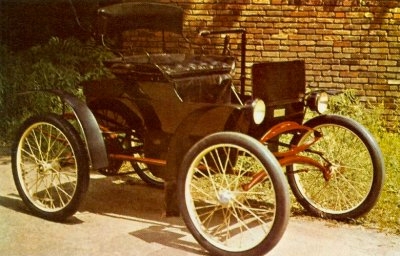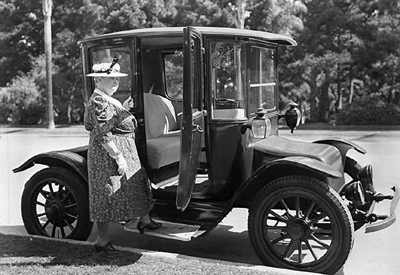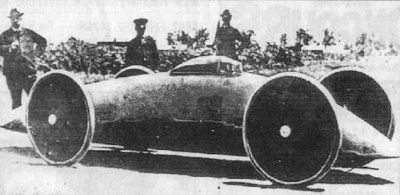Baker Electric Motor Vehicle Company
|
1899
- 1923 |
Country: |
 |
|
Despite their relatively slow speed, electric vehicles had a number of advantages over their early-1900s competitors. They did not have the vibration, smell, and noise associated with gasoline cars. They did not require gear changes, which for gasoline cars was the most difficult part of driving.
Electric cars found popularity among well-heeled customers who used them as city cars, where their limited range proved to be even less of a disadvantage. The cars were also preferred because they did not require a manual effort to start, as did gasoline cars which featured a hand crank to start the engine. Electric cars were often marketed as suitable vehicles for women drivers due to this ease of operation.
And the Baker Motor Vehicle Co, of Cleveland, Ohio were one of the best of the breed, even going so far as to supply an electric-powered Brougham to the King of Siam. The body and running gear were finished in ivory, the folding top was of specially enamelled white leather, and the dashboard and wings were covered in white patent leather, the side panels and the front being emblazoned in silver with the royal crest.
The car was upholstered in 'a delicate pale-green broadcloth, the royal colour of Siam, with silver-grey Persian broad lace tapestry, puff rolls, and silver-grey silk cord and seaming lace'. All the metal parts were silver plated, with special silver lamps and meter case, the lever handles were of pearl, and the curtain lights at each side and at the rear were of bevelled plate-glass. And another feature was almost silent.
Baker was probably the most important and enterprising of the American makers of electric cars. The company was founded by Waiter C. Baker and Fred R. White in 1899, the year in which
Camille Jenatzy established a Land Speed Record of 65.79 mph in the electric
Jamais Contente.
The first Baker was little more than a
battery box and motor on a very lightly sprung four-wheeled frame, but within months the company was making attractive two-seater runabouts for town travel, with tiller
steering and solid tyres. Although the first models were chain-driven, shaft drive was introduced as early as 1902.
It was in this year, also, that Waiter Baker made his first attempt on the
Land Speed Record. The Baker Torpedo was not, in fact, built by the company. Although it was designed by Waiter Baker, it was actually made from his drawings by the Electric Vehicle Co of Hartford, Connecticut.
It had a low, bullet-shaped body, made of white pine covered with oil cloth. The driver and his mechanic sat in tandem, in a fully-enclosed cockpit with small mica windows. The car was powered by a 12 hp Elwell-Parker motor, with chain drive, rather than Baker's newly developed shaft transmission, to the rear axle.
The motor was positioned behind the cockpit and the forty Gould batteries were placed some in front of the driver, some at his back, and some behind the rear suspension. The car, on its 40-inch disc wheels, was 18ft long and weighed 3000 lb.
In April 1902, Leon Serpollet in Nice had set a new record of 75.06mph in his steam car, and, in June, Waiter Baker, with his mechanic C.E. Denzer, made an attempt to better this at Staten Island Boulevard, New York.
 The first Baker electric cars were all battery and body.
The first Baker electric cars were all battery and body.
 The Electric Baker was ideal as a city car, provided the distance was kept to under 50 miles.
The Electric Baker was ideal as a city car, provided the distance was kept to under 50 miles.
 The 1903 Torpedo Kid. It did manage some speed records, before colliding with a Waverley Electric Car.
The 1903 Torpedo Kid. It did manage some speed records, before colliding with a Waverley Electric Car. |
The Torpedo had covered a mile in 47 seconds when disaster struck. Accounts vary, but it seems that spectators strayed on to the track, Baker applied the brake, one of the front wheels collapsed, and the car left the course, killing two people and finishing up virtually destroyed. It was repaired and exhibited in London at the Crystal Palace in 1903, but did not race again.
Baker's next attempt to build a record-breaking car was also in 1903. This was the Torpedo Kid, a lighter, single-seater car. The body was similar in shape to that of the Torpedo, but the cockpit was open. In September it broke several distance speed records at Cleveland, but subsequently crashed after colliding with a Waverley in a race for electric cars.
Baker Electric also played a modest part in military history. In 1909, the prolific arms inventor Dr McLean, of Cleveland, developed an anti-aircraft gun with which he claimed he could pepper a Zeppelin at a rate of 200 shots per minute and a range of 1½ miles. The gun was mounted on a Baker truck, but we do not believe this vehicle was ever mass-manufactured.
Meanwhile, the Baker Company continued to make their handsome broughams and runabouts. They were, of course, intended only for town use, since their range was only about 50 miles on a full
battery charge. The 1910 limousine - which was built to look like a conventional combustion-engined car, with a false bonnet holding the batteries - had a top speed of 30 mph.
Acceptance of electric cars was initially hampered by a lack of power infrastructure, but by 1912, many homes were wired for electricity, enabling a surge in the popularity of the cars. At the turn of the century, 40 percent of American automobiles were powered by steam, 38 percent by electricity, and 22 percent by gasoline.
33,842 electric cars were registered in the United States, and the United States of America became the country where electric cars had gained the most acceptance. Sales of electric cars peaked in 1912.
In 1914 the Baker merged with Rauch & Lang, another electric car manufacturer, and in the following year they took over R.M. Owen. Owen adapted the gearless Entz magnetic transmission which had been provided for the US battleship
New Mexico, and produced the Owen Magnetic car, which was later to be offered in Britain by British Ensign.
With America's entry into World War 1 the production of electric cars by Baker, Rauch & Lang was reduced, but their manufacture continued until well into the 1920s. Subsequently the company has survived as makers of
bodywork and electronic equipment.



